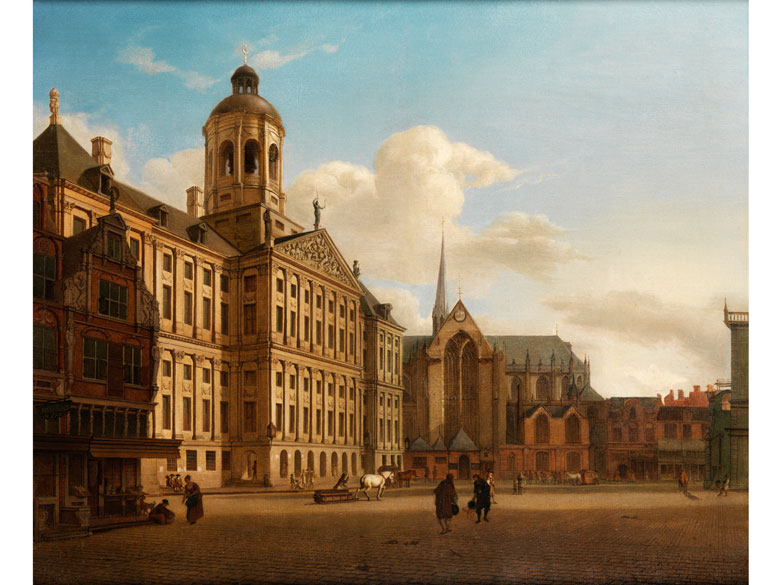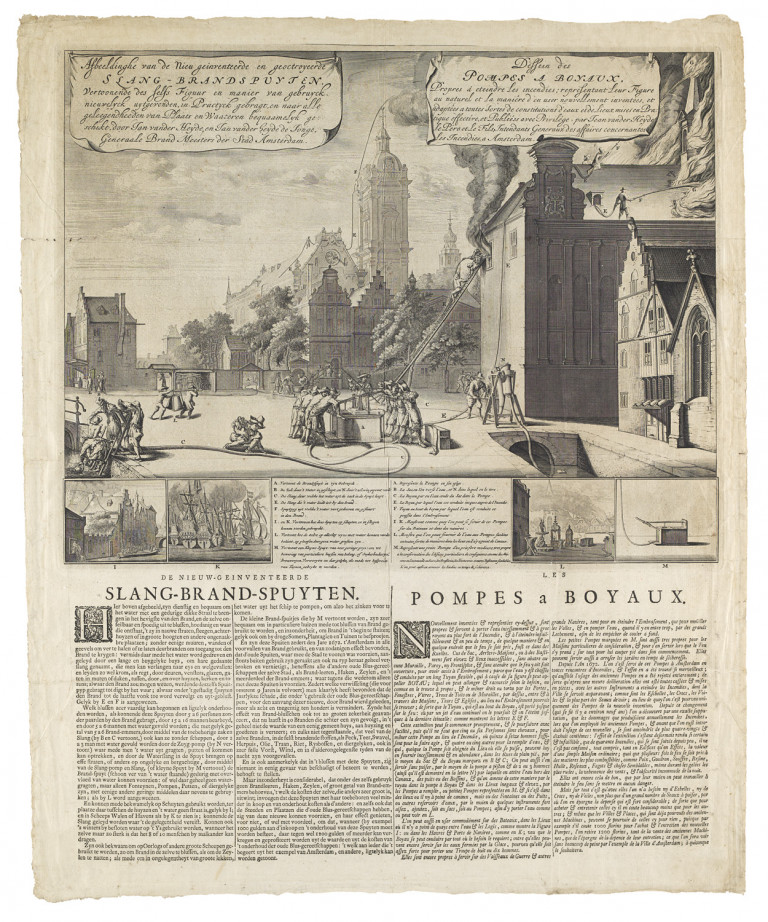Jan van der Heyden (Dutch 1637-1712) and Adriaen van de Velde (Dutch 1636-1672) A river landscape with a fortified castle and a bridge Oil on cradled panel 70 x 57.5cm (27½ x 22½ in.) Provenance: baptiste-pierre-lebrun" title="Jean-Baptiste-Pierre-Lebrun">Jean-Baptiste-Pierre-Lebrun (1748-1813) Sale, Paris, Lebrun, 20 March 1810, Lot 161 (421 francs to Lafontaine) Pierre-Joseph Lafontaine (1758-1835), 5 rue de Cleury, Paris, by whom presumably sold to (or bought on behalf of) Johan Gijsberg, Baron Verstolk van Soelen (1776-1845), The Hague, by 1836, from whom purchased en bloc with his collection in 1849 by a consortium and retained by Humphrey Mildmay (1794-1853) Thence by descent to Henry Bingham Mildmay (1828-1905), London Sale, Christie's, London, Old Master Pictures, 9 July 2003, Lot 52 Acquired from the above by The Lord Wraxall Literature: J. Smith A Catalogue Raisonné, etc., V, London, 1834, p. 397, no. 93. (Possibly) G.F. Waagen, Galleries and Cabinets of Art in Great Britain, London, 1857, p. 342. C. Hofstede de Groot, A Catalogue Raisonné, etc., VIII, London, 1927, p. 372, no. 141. H. Wagner Jan van der Heyden Amsterdam, 1971, p. 105, no. 172. Engraved: J.-B.-P. Le Brun, Recuil de gravures au trait, etc., Paris, 1809, no.161 (for the catalogue of his 1810 sale) Jan Van der Heyden was born in Gorinchem, the son of a Mennonite. In 1646, the family moved to Amsterdam where Van der Heyden remained until his death in 1712. Van der Heyden trained under his eldest brother who produced and sold mirrors. It was during this time that he practiced Verre Églomisé and the two brothers went into business with one another. Van der Heyden went on to become one of the leading architectural landscape painters in the Dutch Golden age painting mainly views of Amsterdam and capriccios. Whilst Van der Heydens attention to detail was exquisite he did not strive for architectural accuracy but overall harmony through his composition. His true mastery was the way in which he bathed landscapes in light in order to manipulate the atmospheric effect. Jan Van der Heyden worked closely with a number of artists on collaborations including Johannes Lingelbach and Eglon van der Neer. However, his closest collaborator was Adriaen van de Velde who was an apprentice of Jan Wynants and trained with Philips Wouwerman Velde painted lively and characterful figures such as the figures on horseback crossing the river in the foreground and the townspeople crossing the river over the bridge to complement Heydens atmospheric landscapes. The collection of baptiste-pierre-lebrun" title="Jean-Baptiste-Pierre-Lebrun">Jean-Baptiste-Pierre-Lebrun husband of the artist Marie-Elisabeth-Louise Vigée Lebrun, was dispersed at auction in Paris in 1810. His collection today is regarded as a rich and important collection which has ended up in some of the worlds most established museums including the Frick Collection, New York and the Hermitage, St. Petersburg. Mildmay's pictures eventually passed to his son Henry Bingham Mildmay (1828-1905), who became a partner of Barings in 1856. Like so many of his mother's family, he collected pictures. However, the Baring crisis of October 1890 brought collecting to an end and on 24 June 1893 a substantial part of Mildmay's picture collection was dispersed at Christie's. The Bank was bailed out by a consortium headed by Henry Hucks Gibbs (a former governor of the Bank of England) and Antony Gibbs and Sons. That a significant number of important pictures were retained, including apparently the present work, testifies to Mildmay's continuing commitment as a collector.
Jan van der Heyden (Dutch 1637-1712) and Adriaen van de Velde (Dutch 1636-1672) A river landscape with a fortified castle and a bridge Oil on cradled panel 70 x 57.5cm (27½ x 22½ in.) Provenance: baptiste-pierre-lebrun" title="Jean-Baptiste-Pierre-Lebrun">Jean-Baptiste-Pierre-Lebrun (1748-1813) Sale, Paris, Lebrun, 20 March 1810, Lot 161 (421 francs to Lafontaine) Pierre-Joseph Lafontaine (1758-1835), 5 rue de Cleury, Paris, by whom presumably sold to (or bought on behalf of) Johan Gijsberg, Baron Verstolk van Soelen (1776-1845), The Hague, by 1836, from whom purchased en bloc with his collection in 1849 by a consortium and retained by Humphrey Mildmay (1794-1853) Thence by descent to Henry Bingham Mildmay (1828-1905), London Sale, Christie's, London, Old Master Pictures, 9 July 2003, Lot 52 Acquired from the above by The Lord Wraxall Literature: J. Smith A Catalogue Raisonné, etc., V, London, 1834, p. 397, no. 93. (Possibly) G.F. Waagen, Galleries and Cabinets of Art in Great Britain, London, 1857, p. 342. C. Hofstede de Groot, A Catalogue Raisonné, etc., VIII, London, 1927, p. 372, no. 141. H. Wagner Jan van der Heyden Amsterdam, 1971, p. 105, no. 172. Engraved: J.-B.-P. Le Brun, Recuil de gravures au trait, etc., Paris, 1809, no.161 (for the catalogue of his 1810 sale) Jan Van der Heyden was born in Gorinchem, the son of a Mennonite. In 1646, the family moved to Amsterdam where Van der Heyden remained until his death in 1712. Van der Heyden trained under his eldest brother who produced and sold mirrors. It was during this time that he practiced Verre Églomisé and the two brothers went into business with one another. Van der Heyden went on to become one of the leading architectural landscape painters in the Dutch Golden age painting mainly views of Amsterdam and capriccios. Whilst Van der Heydens attention to detail was exquisite he did not strive for architectural accuracy but overall harmony through his composition. His true mastery was the way in which he bathed landscapes in light in order to manipulate the atmospheric effect. Jan Van der Heyden worked closely with a number of artists on collaborations including Johannes Lingelbach and Eglon van der Neer. However, his closest collaborator was Adriaen van de Velde who was an apprentice of Jan Wynants and trained with Philips Wouwerman Velde painted lively and characterful figures such as the figures on horseback crossing the river in the foreground and the townspeople crossing the river over the bridge to complement Heydens atmospheric landscapes. The collection of baptiste-pierre-lebrun" title="Jean-Baptiste-Pierre-Lebrun">Jean-Baptiste-Pierre-Lebrun husband of the artist Marie-Elisabeth-Louise Vigée Lebrun, was dispersed at auction in Paris in 1810. His collection today is regarded as a rich and important collection which has ended up in some of the worlds most established museums including the Frick Collection, New York and the Hermitage, St. Petersburg. Mildmay's pictures eventually passed to his son Henry Bingham Mildmay (1828-1905), who became a partner of Barings in 1856. Like so many of his mother's family, he collected pictures. However, the Baring crisis of October 1890 brought collecting to an end and on 24 June 1893 a substantial part of Mildmay's picture collection was dispersed at Christie's. The Bank was bailed out by a consortium headed by Henry Hucks Gibbs (a former governor of the Bank of England) and Antony Gibbs and Sons. That a significant number of important pictures were retained, including apparently the present work, testifies to Mildmay's continuing commitment as a collector.


.jpg)


.jpg?w=400?width=1600&quality=70)


.jpg)
.jpg)




Try LotSearch and its premium features for 7 days - without any costs!
Be notified automatically about new items in upcoming auctions.
Create an alert